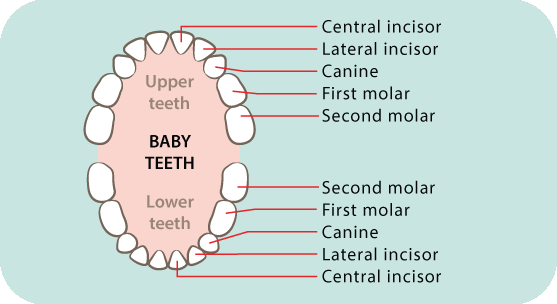Children’s teeth development at 3-5 years
Children’s baby teeth can arrive in any order, although the lower incisors are often first, followed by the upper incisors. The first molars are usually next, followed by the canines and second molars.
All 20 baby teeth usually arrive by the time children are 3 years old.

Dental care to keep preschooler teeth clean
Brush your child’s teeth twice a day – morning and night. Use a pea-sized amount of low-fluoride toothpaste on a child-size toothbrush, unless your dentist recommends otherwise.
Your child might want to start helping to clean their own teeth. You can let your child hold the toothbrush and try brushing their own teeth first. This will help your child feel they’re part of the action. After they’ve had a go, you can finish and make sure that all tooth surfaces are brushed properly.
Also encourage your child to rinse their mouth with water after lunch and snacks. This helps to wash away any leftover food.
Your child needs your help and supervision with keeping teeth clean until they’re about 8 years old.
Diet is an important part of preventing tooth decay. Avoid giving your child sugary foods and sugary drinks like fruit juice, soft drink and flavoured milk.
How to brush children’s teeth properly
You might like to try the following routine when brushing your child’s teeth:
- Stand or sit behind your child so your child feels secure. Brushing teeth in front of a mirror is good too, because it lets you see your child’s mouth.
- Cup your child’s chin in your hands, with their head resting against your body.
- Angle the bristles of the toothbrush towards the gum. If you’re using a manual toothbrush, move the brush in small, gentle circles. If you’re using an electric toothbrush, move the brush gently across the teeth and spend a few seconds on each tooth.
- Brush the outer and inner sides of the teeth and along the gumline. Brush along the chewing surfaces of the teeth.
- Gently brush your child’s tongue.
- After brushing, encourage your child to spit out toothpaste, not swallow it. There’s no need to rinse after brushing because the fluoride toothpaste left behind protects your child’s teeth.
Preschoolers are more likely to go along with cleaning teeth if it’s fun and part of a daily routine. For example, you can sing ‘This is the way we brush our teeth, brush our teeth, brush our teeth’ while you’re brushing. Or you could pretend the toothbrush is a train, saying ‘Toot toot chugga chugga’ as you move it around your child’s teeth.
How to choose children’s toothbrushes and keep them clean
Choosing a toothbrush
It might help to choose a toothbrush designed especially for children aged 2-5 years. These toothbrushes have small, oval heads, soft bristles, and non-slip, cushioned handles. They also often have cartoons and fun designs on the handle, which your child might like.
Electric and manual toothbrushes are equally good if you use them properly to clean all the surfaces of all your child’s teeth. If you’re deciding between a manual and an electric toothbrush, it’s OK to let your child choose.
Keeping the toothbrush clean
After cleaning your child’s teeth and gums, rinse the toothbrush with tap water. Store the toothbrush upright in an open container to allow it to air-dry.
You should replace toothbrushes every 3-4 months or when the bristles get worn or frayed.
Cleaning and caring for children’s teeth early on sets up good dental health habits for life.
Fluoride and dental health for children
Fluoride is a mineral that keeps teeth strong and prevents tooth decay. Fluoride is safe and works best when your child gets it in very small amounts throughout the day from the following sources:
- Toothpaste – your child can use a low-fluoride toothpaste from 18 months.
- Tap water – most tap water in Australia has added fluoride.
Visiting the dentist: a key part of dental care for children
At this age, your child should visit the dentist regularly, even if you think your child’s teeth are healthy. Talk to your dentist about how often your child needs a check-up. Dentists usually recommend every 6-12 months.
Regular dental check-ups give your child the chance to get to know and feel comfortable with the dentist. They also give you and your dentist a chance to talk about your child’s dental health needs and plan your child’s dental care.
Depending on your child’s needs, your child might also see other dental health professionals like dental therapists, dental hygienists, oral health therapists or paediatric dentists.
Dental care for children in Australia
In Australia, children can get dental care in the public system or private system.
The public dental health system provides basic dental care, which is often free or subsidised.
The private dental health system provides both basic and specialist dental care. This usually costs money. Private health insurance and other schemes might partly cover the cost of private dental care.
If you’re eligible, the Australian Government’s Child Dental Benefits Schedule covers basic dental care for children aged 0-17 years at most private and public dental services.
You can visit your state or territory health department website or Teeth.org.au – Government dental care to find out about public dental services near you. You can also search online to find private dental services near you.